An International Proficiency Test to Detect, Identify and Quantify Ricin in Complex Matrices
Abstract
:1. Introduction
2. Results and Discussion
2.1. Preparation of the Ricin Proficiency Test
- (i)
- The samples needed to be detectable with a range of different techniques, as the PT was open with respect to the methods applied by the participants. The expectation of a technically open PT was to obtain information on best analytical practices. To this end, three different concentrations of highly purified ricin (prepared and characterized in [69]) in buffer containing a stabilizing protein were selected: a high (500,000 ng/mL), an intermediate (500 ng/mL) and a low (0.5 ng/mL) concentration of purified ricin in PBS/0.1% BSA.
- (ii)
- For the analyses of the influence of complex matrices on the detection of ricin, the intermediate concentration of ricin (500 ng/mL) was spiked into semi-skimmed milk and a particle-free, sterile extract of minced meat.
- (iii)
- To obtain information on the specificity of different methods, the highly homologous RCA120 was selected (prepared and characterized in [69]). Equivalent concentrations of RCA120 and ricin (500,000 ng/mL and 500 ng/mL) were spiked into buffered solutions (PBS/0.1% BSA).
- (iv)
- Finally, as “real sample”, a commercially available organic fertilizer containing R. communis shred was used that caused a case of dog poisoning in Germany [3]. This material represented a naturally contaminated sample containing unknown concentrations of ricin, RCA120 and the alkaloid ricinine. According to the manufacturer the fertilizer was enriched with a crude R. communis preparation, the press-cake of an industrial castor oil extraction process that is often used as additive in fertilizer as a rich source of nitrogen. The sample was included in the PT to evaluate the laboratories’ sample preparation strategies.
| Samples Selected as Potential PT Samples for Further Stability Testing | PT Sample Number | |
|---|---|---|
| 1 | Negative sample (=buffer: 0.1% BSA/PBS) | S1 |
| 2 | 500,000 ng/mL of ricin in 0.1% BSA/PBS | S6 |
| 3 | 500 ng/mL of ricin in 0.1% BSA/PBS | S3 |
| 4 | 0.5 ng/mL of ricin in 0.1% BSA/PBS | S7 |
| 5 | 500 ng/mL of ricin in semi-skimmed UHT milk | S4 |
| 6 | 500 ng/mL of ricin in extract of minced meat | S8 |
| 7 | 500,000 ng/mL of RCA120 in 0.1% BSA/PBS | S2 |
| 8 | 500 ng/mL of RCA120 in 0.1% BSA/PBS | S5 |
| 9 | Organic fertilizer (solid sample material) | S9 |
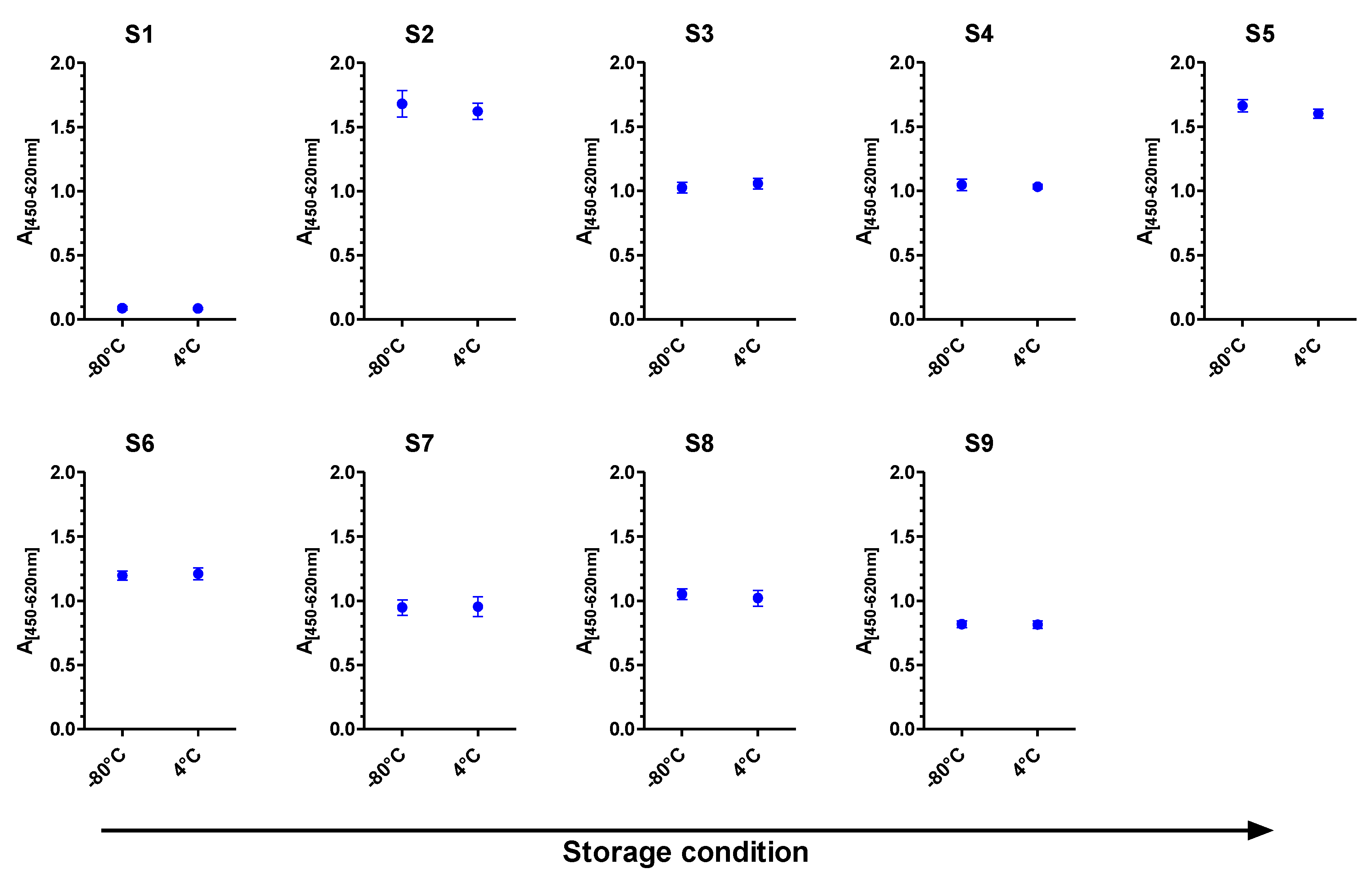
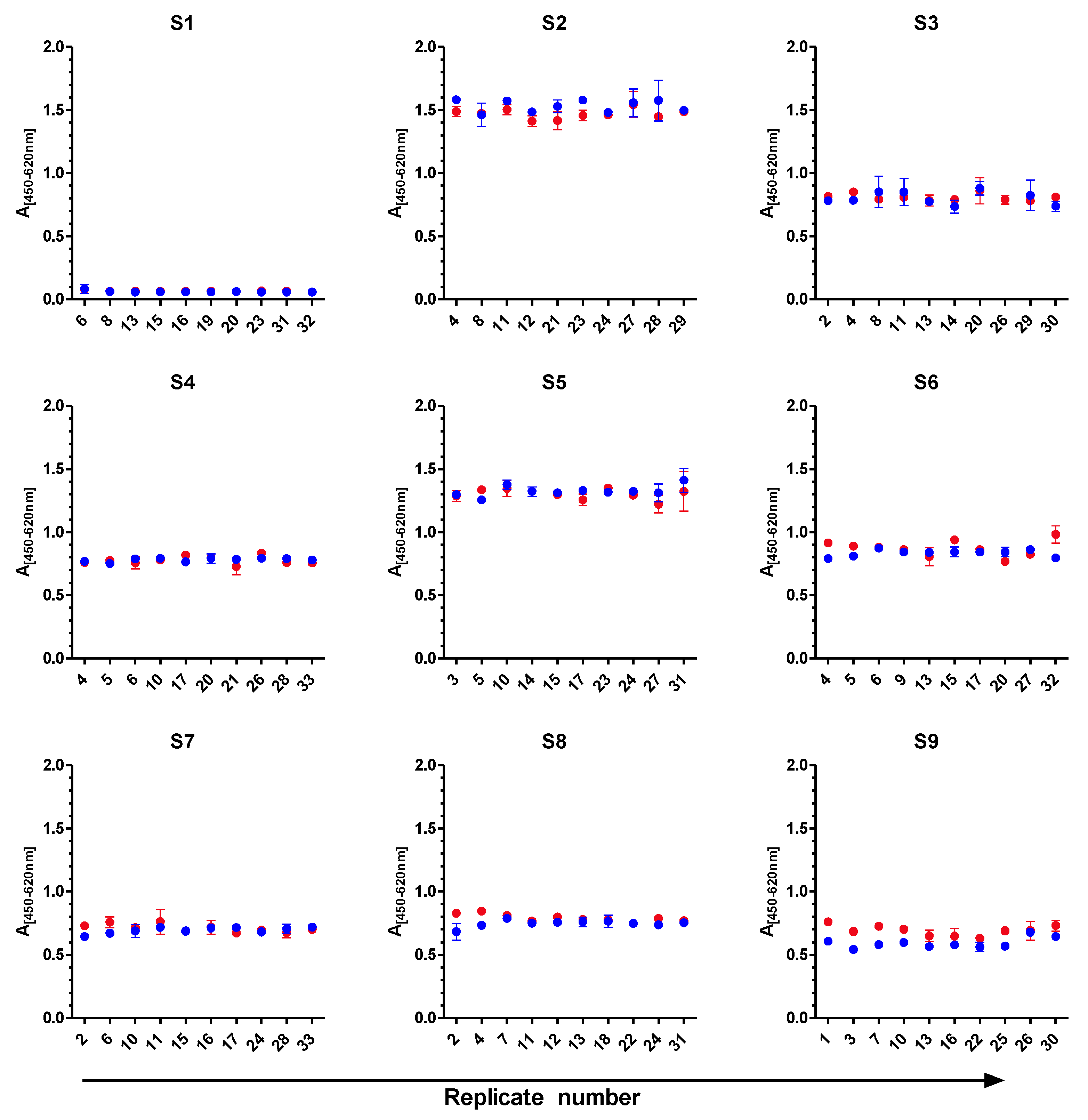
| Sample | Matrix | Measurand | c(Theoretical) * | c(Nominal) ** | σ(rob) | xa | σp | Unit |
|---|---|---|---|---|---|---|---|---|
| S1 | 0.1% BSA/PBS | - | - | - | - | - | - | - |
| S2 | 0.1% BSA/PBS | RCA120 | 500,000 | 572,851 | 62,686 | 563,994 | 143,876 | ng/mL |
| S3 | 0.1% BSA/PBS | Ricin | 500 | 504 | 110 | 522 | 133 | ng/mL |
| S4 | skimmed milk | Ricin | 500 | 473 | 96.3 | 436 | 111 | ng/mL |
| S5 | 0.1% BSA/PBS | RCA120 | 500 | 445 | 65.2 | 481 | 123 | ng/mL |
| S6 | 0.1% BSA/PBS | Ricin | 500,000 | 589,508 | 78,055 | 588,949 | 150,242 | ng/mL |
| S7 | 0.1% BSA/PBS | Ricin | 0.5 | 0.414 | 0.112 | 0.441 | 0.112 | ng/mL |
| S8 | meat extract | Ricin | 500 | 484 | 111 | 508 | 130 | ng/mL |
| S9 | Organic fertilizer | RCA120 | - | 42 | 5.818 | 42 | 52.6 | µg/g |
| Ricin | - | 306 | 71.6 | 206 | 10.7 | µg/g |
2.2. Results of the Ricin Proficiency Test
2.2.1. Qualitative Results of the Ricin Proficiency Test
| Completely correct; for samples S2–S8 differentiation of ricin and RCA120 | |
| Correct; no differentiation of ricin and RCA120 | |
| Partly correct; one of two replicates was correct but not both | |
| Insufficient assignment | |
| Not analyzed |

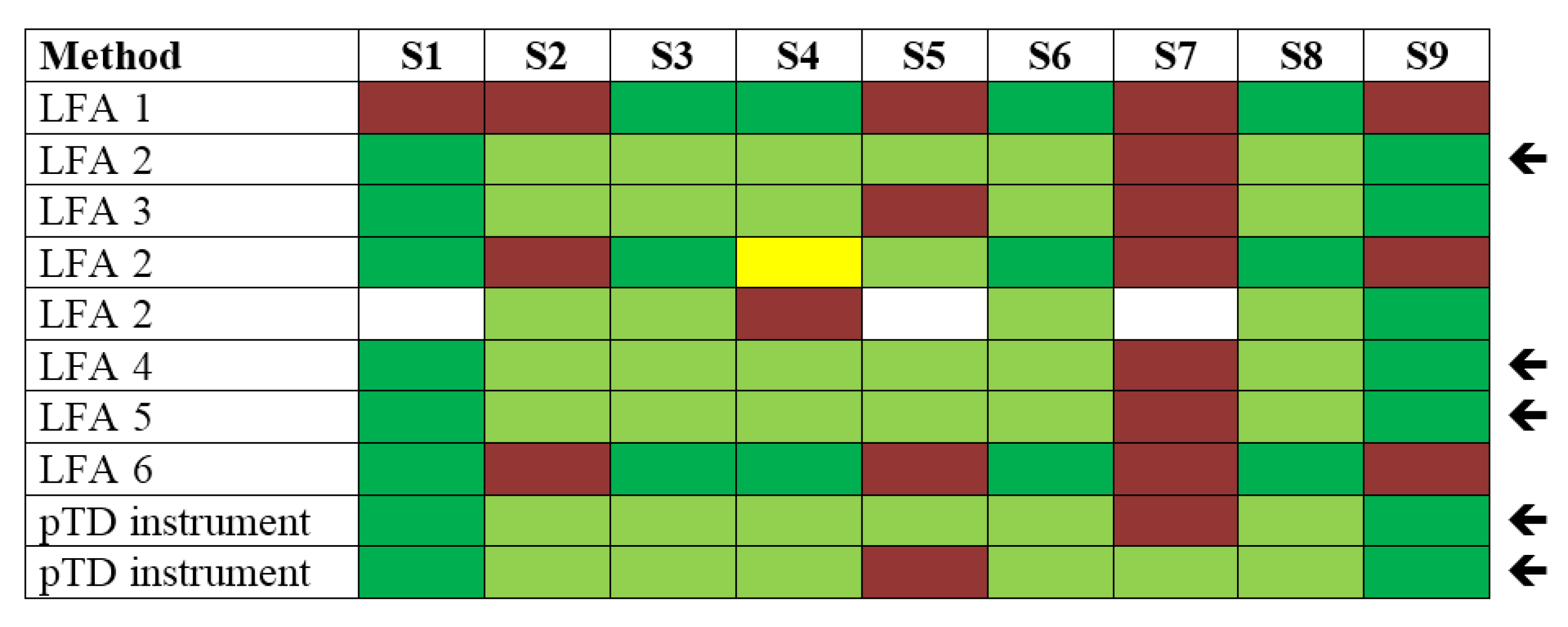
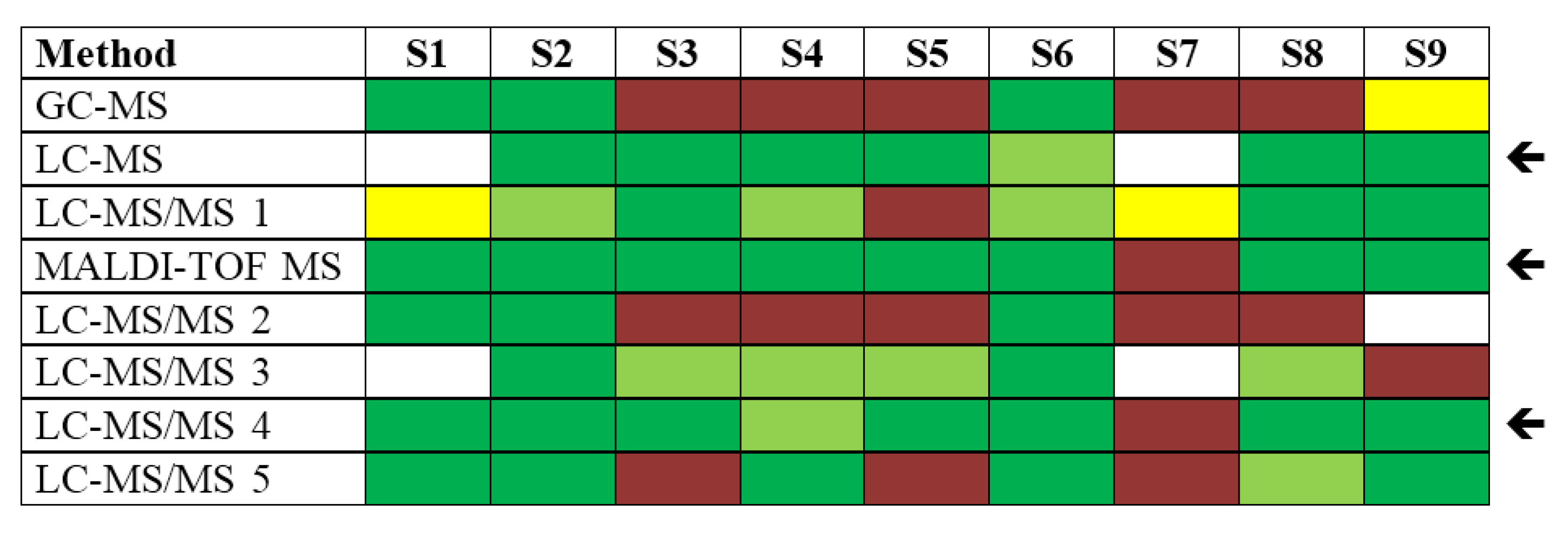
- (i)
- a combination of immunoaffinity enrichment plus detection of the depurination activity of ricin or RCA120 from an artificial substrate (MS-based adenine release assay);
- (ii)
- a cell-based cytotoxicity assay detecting the cell death induced by ricin or RCA120.

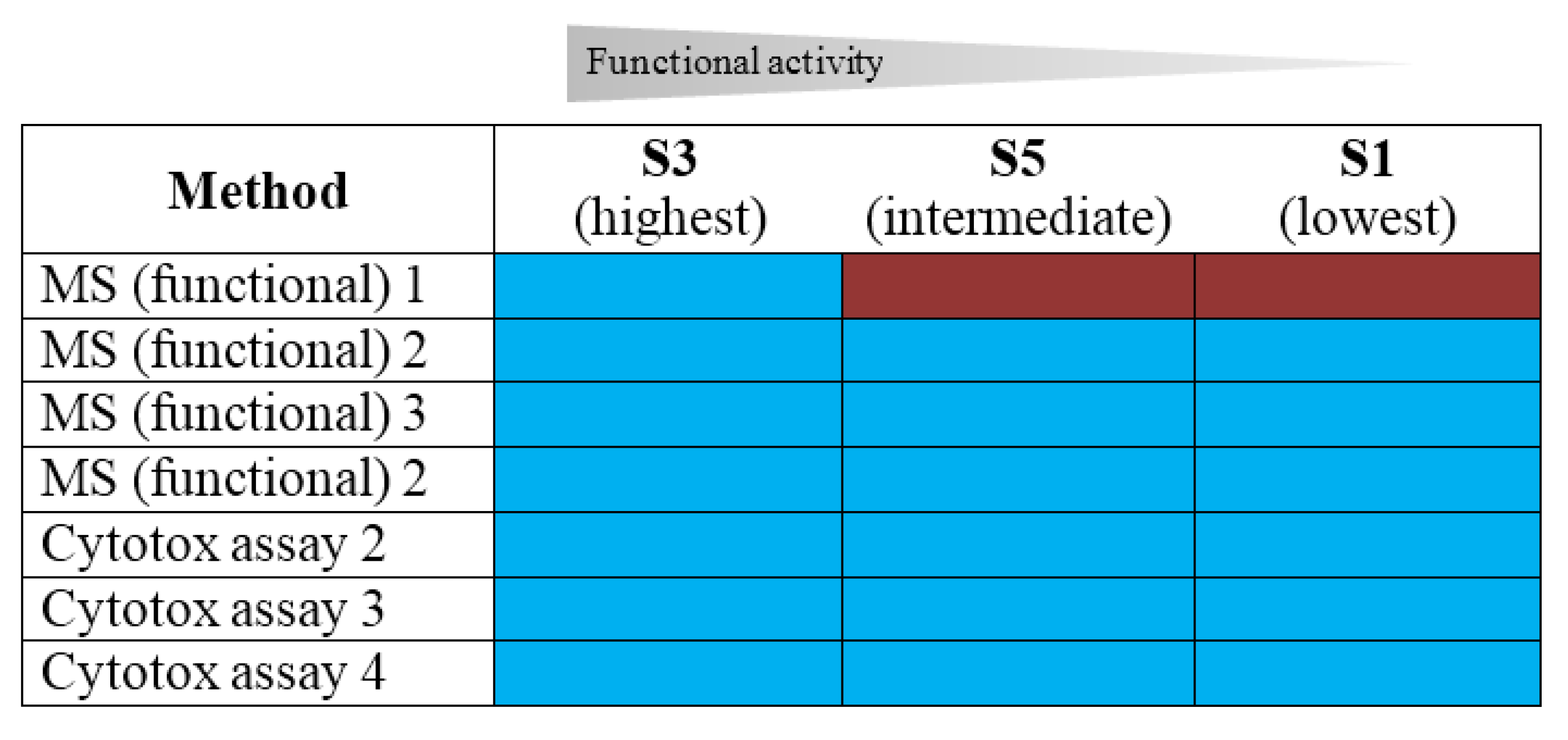
| Main Assay Principle | Method | Total Number of Results | Number of Laboratories | Correct Results | % | Total % |
|---|---|---|---|---|---|---|
| Immunological Method | ELISA | 103 | 7 | correct positive | 64.1 | 77.7 |
| correct negative | 13.6 | |||||
| On-site detection (LFA, pTD) | 165 | 10 | correct positive | 60.6 | 71.5 | |
| correct negative | 10.9 | |||||
| MS-Based Method | MS detection | 117 | 8 | correct positive | 42.7 | 73.5 |
| correct negative | 30.8 | |||||
| Functional Method | Functional MS assay (Adenine release) | 29 | 4 | correct positive | 62.1 | 75.9 |
| correct negative | 13.8 | |||||
| Cytotoxicity assay | 35 | 4 | correct positive | 51.4 | 74.3 | |
| correct negative | 22.9 |
| Main Assay Principle # | S6 Ricinhigh (588,949 ng/mL) | S2 RCA120high (563,994 ng/mL) | S3 Ricinintermediate (522 ng/mL) | S5 RCA120intermediate (481 ng/mL) | S7 Ricinlow (0.441 ng/mL) |
|---|---|---|---|---|---|
| Immunol. method | 71 | 43 | 63 | 27 | 21 |
| MS-based method | 87 | 79 | 50 | 39 | 8 |
| Functional method | 43 | 57 | 54 | 42 | 0 |
2.2.2. Quantitative Results of the Ricin Proficiency Test
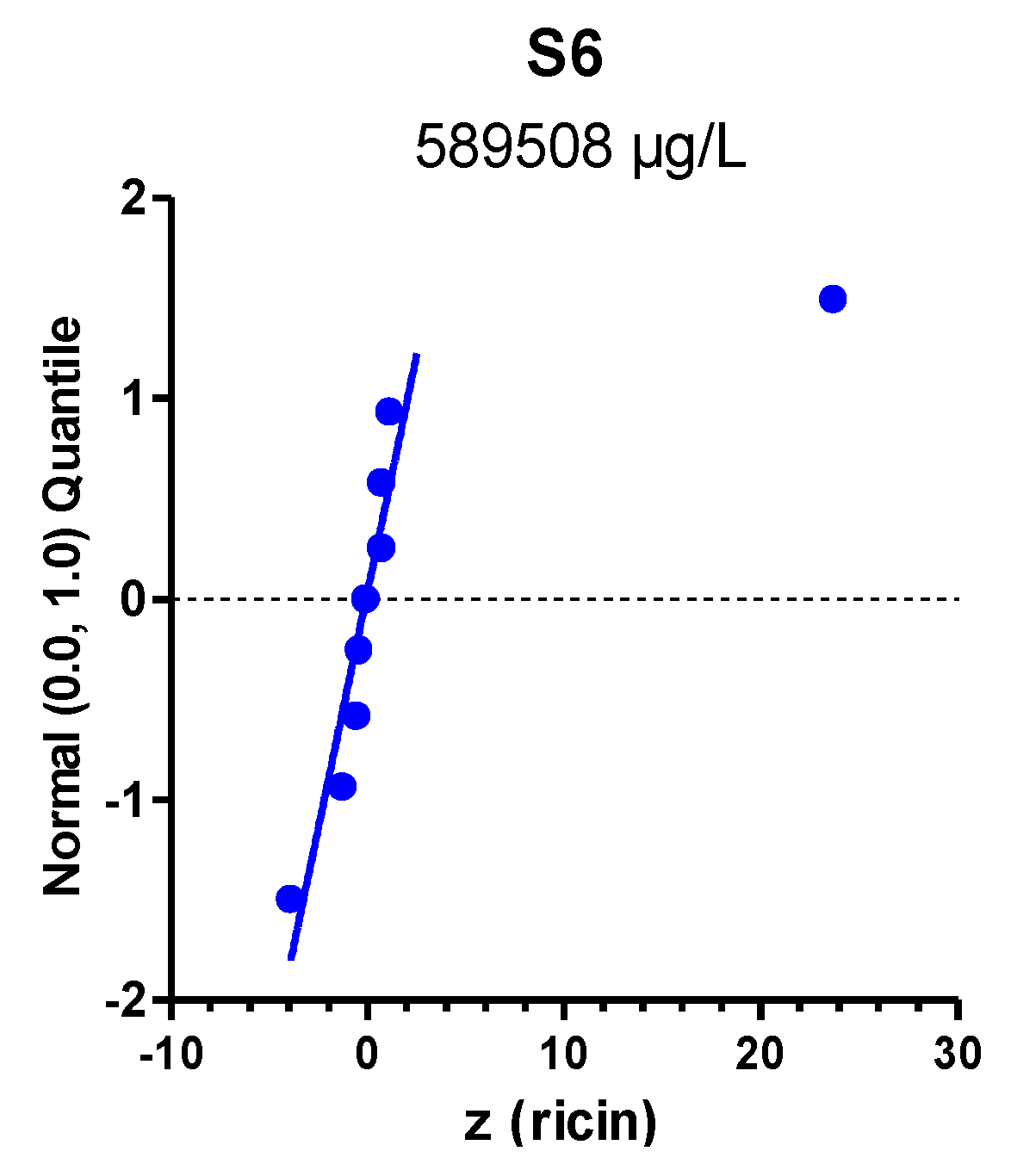
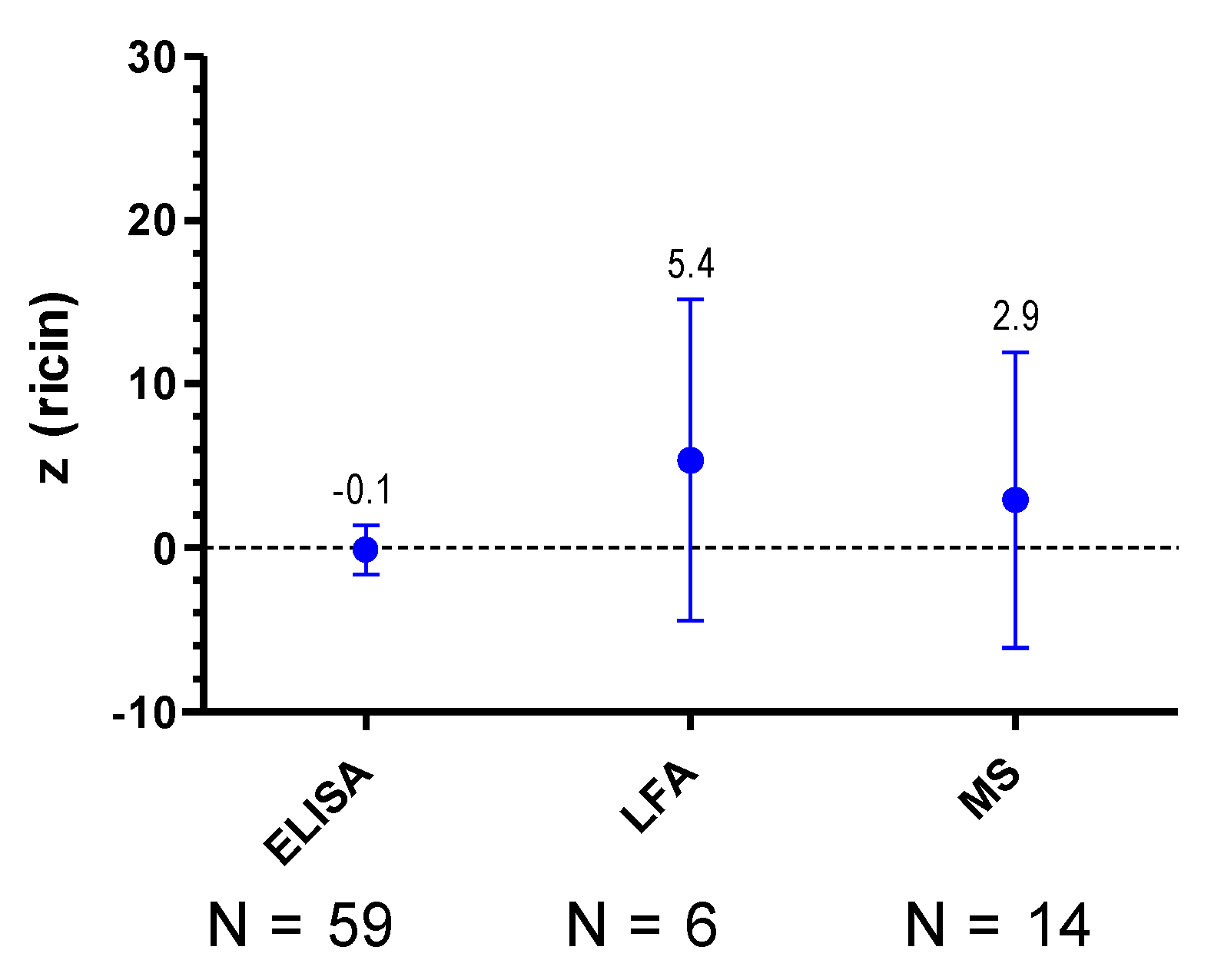
3. Experimental Section
3.1. Preparation of PT Samples
3.2. Amplified Sandwich ELISAs for Ricin and RCA120
3.3. Stability and Homogeneity Testing, Nominal Concentration
3.4. Statistical Analysis and Data Visualization
4. Conclusions
Acknowledgments
Author Contributions
Conflicts of Interest
References
- Stillmark, H. Über Ricin, ein giftiges Fragment aus den Samen von Ricinus comm. L und einigen anderen Euphorbiaceen. Ph.D. Thesis, Kaiserliche Universität zu Dorpat (University of Tartu), Tartu, Estonia, February 1888. [Google Scholar]
- Lappi, D.A.; Kapmeyer, W.; Beglau, J.M.; Kaplan, N.O. The disulfide bond connecting the chains of ricin. Proc. Natl. Acad. Sci. USA 1978, 75, 1096–1100. [Google Scholar] [CrossRef] [PubMed]
- Worbs, S.; Köhler, K.; Pauly, D.; Avondet, M.A.; Schaer, M.; Dorner, M.B.; Dorner, B.G. Ricinus communis intoxications in human and veterinary medicine—A summary of real cases. Toxins 2011, 3, 1332–1372. [Google Scholar] [CrossRef] [PubMed]
- Baenziger, J.U.; Fiete, D. Structural determinants of Ricinus communis agglutinin and toxin specificity for oligosaccharides. J. Biol. Chem. 1979, 254, 9795–9799. [Google Scholar] [PubMed]
- Olsnes, S.; Saltvedt, E.; Pihl, A. Isolation and comparison of galactose-binding lectins from Abrus precatorius and Ricinus communis. J. Biol. Chem. 1974, 249, 803–810. [Google Scholar] [PubMed]
- Sandvig, K.; van Deurs, B. Endocytosis and intracellular transport of ricin: Recent discoveries. FEBS Lett. 1999, 452, 67–70. [Google Scholar] [CrossRef]
- Lord, J.; Roberts, L.; Robertus, J. Ricin: Structure, mode of action, and some current applications. FASEB J. 1994, 8, 201–208. [Google Scholar] [CrossRef] [PubMed]
- Sweeney, E.C.; Tonevitsky, A.G.; Temiakov, D.E.; Agapov, I.I.; Saward, S.; Palmer, R.A. Preliminary crystallographic characterization of ricin agglutinin. Proteins Struct. Funct. Bioinform. 1997, 28, 586–589. [Google Scholar] [CrossRef]
- Roberts, L.M.; Lamb, F.I.; Pappin, D.J.; Lord, J.M. The primary sequence of Ricinus communis agglutinin. Comparison with ricin. J. Biol. Chem. 1985, 260, 15682–15686. [Google Scholar] [PubMed]
- Brandt, N.N.; Chikishev, A.Y.; Sotnikov, A.I.; Savochkina, Y.A.; Agapov, I.I.; Tonevitskii, A.G.; Kirpichnikov, M.P. Conformational difference between ricin and ricin agglutinin in solution and crystal. Dokl. Biochem. Biophys. 2001, 376, 26–28. [Google Scholar] [CrossRef] [PubMed]
- Saltvedt, E. Structure and toxicity of pure ricinus agglutinin. Biochim. Biophys. Acta 1976, 451, 536–548. [Google Scholar] [CrossRef]
- Araki, T.; Funatsu, G. The complete amino acid sequence of the B-chain of ricin E isolated from small-grain castor bean seeds. Ricin E is a gene recombination product of ricin D and Ricinus communis agglutinin. Biochim. Biophys. Acta 1987, 911, 191–200. [Google Scholar] [CrossRef]
- Ladin, B.F.; Murray, E.E.; Halling, A.C.; Halling, K.C.; Tilakaratne, N.; Long, G.L.; Houston, L.L.; Weaver, R.F. Characterization of a cDNA encoding ricin E, a hybrid ricin-Ricinus communis agglutinin gene from the castor plant Ricinus communis. Plant Mol. Biol. 1987, 9, 287–295. [Google Scholar] [CrossRef] [PubMed]
- Mise, T.; Funatsu, G.; Ishiguro, M.; Funatsu, M. Isolation and characterization of ricin E from castor beans. Agric. Biol. Chem. 1977, 41, 2041–2046. [Google Scholar] [CrossRef]
- Chan, A.P.; Crabtree, J.; Zhao, Q.; Lorenzi, H.; Orvis, J.; Puiu, D.; Melake-Berhan, A.; Jones, K.M.; Redman, J.; Chen, G.; et al. Draft genome sequence of the oilseed species Ricinus communis. Nat. Biotechnol. 2010, 28, 951–956. [Google Scholar] [CrossRef] [PubMed]
- Leshin, J.; Danielsen, M.; Credle, J.J.; Weeks, A.; O’Connell, K.P.; Dretchen, K. Characterization of ricin toxin family members from Ricinus communis. Toxicon 2010, 55, 658–661. [Google Scholar] [CrossRef] [PubMed]
- Despeyroux, D.; Walker, N.; Pearce, M.; Fisher, M.; McDonnell, M.; Bailey, S.C.; Griffiths, G.D.; Watts, P. Characterization of ricin heterogeneity by electrospray mass spectrometry, capillary electrophoresis, and resonant mirror. Anal. Biochem. 2000, 279, 23–36. [Google Scholar] [CrossRef] [PubMed]
- Sehgal, P.; Khan, M.; Kumar, O.; Vijayaraghavan, R. Purification, characterization and toxicity profile of ricin isoforms from castor beans. Food Chem. Toxicol. 2010, 48, 3171–3176. [Google Scholar] [CrossRef] [PubMed]
- Sehgal, P.; Kumar, O.; Kameswararao, M.; Ravindran, J.; Khan, M.; Sharma, S.; Vijayaraghavan, R.; Prasad, G.B.K.S. Differential toxicity profile of ricin isoforms correlates with their glycosylation levels. Toxicology 2011, 282, 56–67. [Google Scholar] [CrossRef] [PubMed]
- Bergström, T.; Fredriksson, S.Å.; Nilsson, C.; Åstot, C. Deamidation in ricin studied by capillary zone electrophoresis- and liquid chromatography-mass spectrometry. J. Chromatogr. B Analyt. Technol. Biomed. Life Sci. 2015, 974, 109–117. [Google Scholar] [CrossRef] [PubMed]
- Ogunniyi, D.S. Castor oil: A vital industrial raw material. Bioresour. Technol. 2006, 97, 1086–1091. [Google Scholar] [CrossRef] [PubMed]
- Strebhardt, K.; Ullrich, A. Paul Ehrlich’s magic bullet concept: 100 years of progress. Nat. Rev. Cancer 2008, 8, 473–480. [Google Scholar] [CrossRef] [PubMed]
- Tyagi, N.; Tyagi, M.; Pachauri, M.; Ghosh, P.C. Potential therapeutic applications of plant toxin-ricin in cancer: Challenges and advances. Tumour Biol. 2015. [Google Scholar] [CrossRef] [PubMed]
- Frankel, A.E.; Woo, J.H.; Neville, D.M. Principles of Cancer Biotherapy, 5th ed.; Springer: Dodrecht, The Netherland, 2009. [Google Scholar]
- Schindler, J.; Gajavelli, S.; Ravandi, F.; Shen, Y.; Parekh, S.; Braunchweig, I.; Barta, S.; Ghetie, V.; Vitetta, E.; Verma, A. A phase I study of a combination of anti-CD19 and anti-CD22 immunotoxins (Combotox) in adult patients with refractory B-lineage acute lymphoblastic leukaemia. Br. J. Haematol. 2011, 154, 1–6. [Google Scholar] [CrossRef] [PubMed]
- Spitler, L.E.; del Rio, M.; Khentigan, A.; Wedel, N.I.; Brophy, N.A.; Miller, L.L.; Harkonen, W.S.; Rosendorf, L.L.; Lee, H.M.; Mischak, R.P.; et al. Therapy of Patients with Malignant Melanoma Using a Monoclonal Antimelanoma Antibody-Ricin A Chain Immunotoxin. Cancer Res. 1987, 47, 1717–1723. [Google Scholar] [PubMed]
- Zhou, X.X.; Ji, F.; Zhao, J.L.; Cheng, L.F.; Xu, C.F. Anti-cancer activity of anti-p185HER-2 ricin A chain immunotoxin on gastric cancer cells. J. Gastroenterol. Hepatol. 2010, 25, 1266–1275. [Google Scholar] [CrossRef] [PubMed]
- Audi, J.; Belson, M.; Patel, M.; Schier, J.; Osterloh, J. Ricin poisoning: A comprehensive review. J. Am. Med. Assoc. 2005, 294, 2342–2351. [Google Scholar] [CrossRef] [PubMed]
- Franz, D.R.; Jaax, N.K. Ricin toxin. In Medical Aspects of Chemical and Biological Warfare; Sidell, F.R., Takafuji, E.T., Franz, D.R., Eds.; TMM Publications: Washington, DC, USA, 1997; pp. 631–642. [Google Scholar]
- Kirby, R. Ricin toxin: A military history. CML Army Chem. Rev. 2004, 304, 38–40. [Google Scholar]
- Zilinskas, R.A. Iraq’s biological weapons. J. Am. Med. Assoc. 1997, 278, 418–424. [Google Scholar] [CrossRef]
- Moran, G.J. Threats in bioterrorism. II: CDC category B and C agents. Emerg. Med. Clin. N. Am. 2002, 20, 311–330. [Google Scholar] [CrossRef]
- Schieltz, D.M.; McGrath, S.C.; McWilliams, L.G.; Rees, J.; Bowen, M.D.; Kools, J.J.; Dauphin, L.A.; Gomez-Saladin, E.; Newton, B.N.; Stang, H.L.; et al. Analysis of active ricin and castor bean proteins in a ricin preparation, castor bean extract, and surface swabs from a public health investigation. Forensic Sci. Int. 2011, 209, 70–79. [Google Scholar] [CrossRef] [PubMed]
- Hayden, E.C.; Wadman, M. US ricin attacks are more scary than harmful. Nat. News 2013. [Google Scholar] [CrossRef]
- Alderton, M.R.; Paddle, B. A sensitive enzyme linked immunosorbent assay (ELISA) for the detection of ricin in blood. DSTO Aeronaut. Mar. Res. Lab. 1997, 9, 1–12. [Google Scholar]
- Gaylord, S.T.; Dinh, T.L.; Goldman, E.R.; Anderson, G.P.; Ngan, K.C.; Walt, D.R. Ultrasensitive detection of ricin toxin in multiple sample matrixes using single-domain antibodies. Anal. Chem. 2015, 87, 6570–6577. [Google Scholar] [CrossRef] [PubMed]
- Leith, A.G.; Griffiths, G.D.; Green, M.A. Quantification of ricin toxin using a highly sensitive avidin/biotin enzyme-linked immunosorbent assay. J. Forensic Sci. Soc. 1988, 28, 227–236. [Google Scholar] [CrossRef]
- Pauly, D.; Kirchner, S.; Stoermann, B.; Schreiber, T.; Kaulfuss, S.; Schade, R.; Zbinden, R.; Avondet, M.A.; Dorner, M.B.; Dorner, B.G. Simultaneous quantification of five bacterial and plant toxins from complex matrices using a multiplexed fluorescent magnetic suspension assay. Analyst 2009, 134, 2028–2039. [Google Scholar] [CrossRef] [PubMed]
- Griffiths, G.D.; Newman, H.; Gee, D.J. Identification and quantification of ricin toxin in animal tissues using ELISA. J. Forensic Sci. Soc. 1986, 26, 349–358. [Google Scholar] [CrossRef]
- Shyu, H.F.; Chiao, D.J.; Liu, H.W.; Tang, S.S. Monoclonal antibody-based enzyme immunoassay for detection of ricin. Hybrid. Hybridomics 2002, 21, 69–73. [Google Scholar] [CrossRef] [PubMed]
- Shyu, R.H.; Shyu, H.F.; Liu, H.W.; Tang, S.S. Colloidal gold-based immunochromatographic assay for detection of ricin. Toxicon 2002, 40, 255–258. [Google Scholar] [CrossRef]
- Simon, S.; Worbs, S.; Avondet, M.A.; Tracz, D.M.; Dano, J.; Volland, H.; Dorner, B.G.; Corbett, C.R. Recommended immunological assays to screen for ricin-containing samples. Toxins 2015, 7. [Google Scholar] [CrossRef]
- Thullier, P.; Griffiths, G. Broad recognition of ricin toxins prepared from a range of Ricinus cultivars using immunochromatographic tests. Clin. Toxicol. 2009, 47, 643–650. [Google Scholar] [CrossRef] [PubMed]
- Portable Toxin Detector. Available online: https://www.bruker.com/de/products/cbrne-detection/elisa/ptd/ overview.html (accessed on 13 October 2015).
- Narang, U.; Anderson, G.P.; Ligler, F.S.; Burans, J. Fiber optic-based biosensor for ricin. Biosens. Bioelectron. 1997, 12, 937–945. [Google Scholar] [CrossRef]
- Zhuang, J.; Cheng, T.; Gao, L.; Luo, Y.; Ren, Q.; Lu, D.; Tang, F.; Ren, X.; Yang, D.; Feng, J.; et al. Silica coating magnetic nanoparticle-based silver enhancement immunoassay for rapid electrical detection of ricin toxin. Toxicon 2010, 55, 145–152. [Google Scholar] [CrossRef] [PubMed]
- Brinkworth, C.S.; Pigott, E.J.; Bourne, D.J. Detection of intact ricin in crude and purified extracts from castor beans using matrix-assisted laser desorption ionization mass spectrometry. Anal. Chem. 2009, 81, 1529–1535. [Google Scholar] [CrossRef] [PubMed]
- Dupre, M.; Gilquin, B.; Fenaille, F.; Feraudet-Tarisse, C.; Dano, J.; Ferro, M.; Simon, S.; Junot, C.; Brun, V.; Becher, F. Multiplex Quantification of Protein Toxins in Human Biofluids and Food Matrices Using Immunoextraction and High-Resolution Targeted Mass Spectrometry. Anal. Chem. 2015, 87, 8473–8480. [Google Scholar] [CrossRef] [PubMed]
- Fredriksson, S.Å.; Artursson, E.; Bergström, T.; Östin, A.; Nilsson, C.; Åstot, C. Identification of RIP-II toxins by affinity enrichment, enzymatic digestion and LC-MS. Anal. Chem. 2015, 87, 967–974. [Google Scholar] [CrossRef] [PubMed]
- Fredriksson, S.-Å.; Hulst, A.G.; Artursson, E.; de Jong, A.L.; Nilsson, C.; van Baar, B.L. Forensic identification of neat ricin and of ricin from crude castor bean extracts by mass spectrometry. Anal. Chem. 2005, 77, 1545–1555. [Google Scholar] [CrossRef] [PubMed]
- McGrath, S.C.; Schieltz, D.M.; McWilliams, L.G.; Pirkle, J.L.; Barr, J.R. Detection and quantification of ricin in beverages using isotope dilution tandem mass spectrometry. Anal. Chem. 2011, 83, 2897–2905. [Google Scholar] [CrossRef] [PubMed]
- Norrgran, J.; Williams, T.L.; Woolfitt, A.R.; Solano, M.I.; Pirkle, J.L.; Barr, J.R. Optimization of digestion parameters for protein quantification. Anal. Biochem. 2009, 393, 48–55. [Google Scholar] [CrossRef] [PubMed]
- Östin, A.; Bergström, T.; Fredriksson, S.Å.; Nilsson, C. Solvent-assisted trypsin digestion of ricin for forensic identification by LC-ESI MS/MS. Anal. Chem. 2007, 79, 6271–6278. [Google Scholar] [CrossRef] [PubMed]
- Bevilacqua, V.L.; Nilles, J.M.; Rice, J.S.; Connell, T.R.; Schenning, A.M.; Reilly, L.M.; Durst, H.D. Ricin activity assay by direct analysis in real time mass spectrometry detection of adenine release. Anal. Chem. 2010, 82, 798–800. [Google Scholar] [CrossRef] [PubMed]
- Hale, M.L. Microtiter-based assay for evaluating the biological activity of ribosome-inactivating proteins. Pharmacol. Toxicol. 2001, 88, 255–260. [Google Scholar] [CrossRef] [PubMed]
- He, X.; Lu, S.; Cheng, L.W.; Rasooly, R.; Carter, J.M. Effect of food matrices on the biological activity of ricin. J. Food Prot. 2008, 71, 2053–2058. [Google Scholar] [PubMed]
- Hines, H.B.; Brueggemann, E.E.; Hale, M.L. High-performance liquid chromatography-mass selective detection assay for adenine released from a synthetic RNA substrate by ricin A chain. Anal. Biochem. 2004, 330, 119–122. [Google Scholar] [CrossRef] [PubMed]
- Keener, W.K.; Rivera, V.R.; Young, C.C.; Poli, M.A. An activity-dependent assay for ricin and related RNA N-glycosidases based on electrochemiluminescence. Anal. Biochem. 2006, 357, 200–207. [Google Scholar] [CrossRef] [PubMed]
- Langer, M.; Rothe, M.; Eck, J.; Mockel, B.; Zinke, H. A nonradioactive assay for ribosome-inactivating proteins. Anal. Biochem. 1996, 243, 150–153. [Google Scholar] [CrossRef] [PubMed]
- Pauly, D.; Worbs, S.; Kirchner, S.; Shatohina, O.; Dorner, M.B.; Dorner, B.G. Real-time cytotoxicity assay for rapid and sensitive detection of ricin from complex matrices. PLoS ONE 2012, 7, e35360. [Google Scholar] [CrossRef] [PubMed]
- Roday, S.; Sturm, M.B.; Blakaj, D.; Schramm, V.L. Detection of an abasic site in RNA with stem-loop DNA beacons: Application to an activity assay for Ricin Toxin A-Chain. J. Biochem. Biophys. Methods 2008, 70, 945–953. [Google Scholar] [CrossRef] [PubMed]
- Vang, O.; Larsen, K.P.; Bøg-Hansen, T.C. A new quantitative and highly specific assay for lectinbinding activity. In Lectins; Walter de Gruyter & Co.: Berlin, Germany, 1986; Volume 6, pp. 637–644. [Google Scholar]
- Brzezinski, J.L.; Craft, D.L. Evaluation of an in vitro bioassay for the detection of purified ricin and castor bean in beverages and liquid food matrices. J. Food Prot. 2007, 70, 2377–2382. [Google Scholar] [PubMed]
- Colombatti, M.; Johnson, V.G.; Skopicki, H.A.; Fendley, B.; Lewis, M.S.; Youle, R.J. Identification and characterization of a monoclonal antibody recognizing a galactose-binding domain of the toxin ricin. J. Immunol. 1987, 138, 3339–3344. [Google Scholar] [PubMed]
- Halter, M.; Almeida, J.L.; Tona, A.; Cole, K.D.; Plant, A.L.; Elliott, J.T. A mechanistically relevant cytotoxicity assay based on the detection of cellular GFP. Assay Drug Dev. Technol. 2009, 7, 356–365. [Google Scholar] [CrossRef] [PubMed]
- Oda, T.; Komatsu, N.; Muramatsu, T. Cell lysis induced by ricin D and ricin E in various cell lines. Biosci. Biotechnol. Biochem. 1997, 61, 291–297. [Google Scholar] [CrossRef] [PubMed]
- Becher, F.; Duriez, E.; Volland, H.; Tabet, J.C.; Ezan, E. Detection of functional ricin by immunoaffinity and liquid chromatography-tandem mass spectrometry. Anal. Chem. 2007, 79, 659–665. [Google Scholar] [CrossRef] [PubMed]
- Kalb, S.R.; Barr, J.R. Mass spectrometric detection of ricin and its activity in food and clinical samples. Anal. Chem. 2009, 81, 2037–2042. [Google Scholar] [CrossRef] [PubMed]
- Worbs, S.; Skiba, M.; Söderström, M.; Rapinoja, M.L.; Zeleny, R.; Russmann, H.; Schimmel, H.; Vanninen, P.; Fredriksson, S.-Å.; Dorner, B.G. Characterization of Ricin and R. communis Agglutinin Reference Materials. Toxins 2015, 7. [Google Scholar] [CrossRef]
- International Organization for Standardization. ISO/IEC 17043 Conformity Assessment—General Requirements for Proficiency Testing; International Organization for Standardization: Geneva, Switzerland, 2010. [Google Scholar]
- Thompson, M.; Ellison, S.L.R.; Wood, R. The International Harmonized Protocol for the proficiency testing of analytical chemistry laboratories (IUPAC Technical Report). Pure Appl. Chem. 2006, 78, 145–196. [Google Scholar] [CrossRef]
- International Organization for Standardization. ISO 5725–5 Accuracy (Trueness and Precision) of Measurement Methods and Results—Part 5: Alternative Methods for the Determination of the Precision of a Standard Measurement Method; International Organization for Standardization: Geneva, Switzerland, 1998. [Google Scholar]
- Slotved, H.C.; Sparding, N.; Tanassi, J.T.; Steenhard, N.R.; Heegaard, N.H. Evaluating 6 ricin field detection assays. Biosecur. Bioterror. 2014, 12, 186–189. [Google Scholar] [CrossRef] [PubMed]
- Weber, M.; Schulz, H. Immunological detection of ricin and castor seeds in beverages, food and consumer products. Toxichem. Krimtech. 2011, 78, 276–277. [Google Scholar]
- Hodge, D.R.; Prentice, K.W.; Ramage, J.G.; Prezioso, S.; Gauthier, C.; Swanson, T.; Hastings, R.; Basavanna, U.; Datta, S.; Sharma, S.K.; et al. Comprehensive laboratory evaluation of a highly specific lateral flow assay for the presumptive identification of ricin in suspicious white powders and environmental samples. Biosecur. Bioterror. 2013, 11, 237–250. [Google Scholar] [CrossRef] [PubMed]
- Kalb, S.R.; Schieltz, D.M.; Becher, F.; Astot, C.; Fredriksson, S.Å.; Barr, J.R. Recommended Mass Spectrometry-Based Strategies to Identify Ricin-Containing Samples. Toxins 2015, 7. [Google Scholar] [CrossRef] [PubMed]
- Worbs, S.; Fiebig, U.; Zeleny, R.; Schimmel, H.; Rummel, A.; Luginbühl, W.; Dorner, B.G. Qualitative and quantitative detection of botulinum neurotoxins from complex matrices: Results of the first international proficiency test. Toxins 2015, 7. [Google Scholar] [CrossRef]
- Garber, E.A.; O'Brien, T.W. Detection of ricin in food using electrochemiluminescence-based technology. J. AOAC Int. 2008, 91, 376–382. [Google Scholar] [PubMed]
- International Organization for Standardization. ISO 13528 Statistical Methods for Use in Proficiency Testing by Interlaboratory Comparisons; International Organization for Standardization: Geneva, Switzerland, 2005; pp. 1–76. [Google Scholar]
- Popova, E.N. Interaction between Ricin and Hybridoma Cells Secreting Antibodies Specific for the Catalytic Subunit; Lomonosov Moscow State University: Moscow, Russia, 2004. (In Russian) [Google Scholar]
- Pauly, D.; Dorner, M.; Zhang, X.; Hlinak, A.; Dorner, B.; Schade, R. Monitoring of laying capacity, immunoglobulin Y concentration, and antibody titer development in chickens immunized with ricin and botulinum toxins over a two-year period. Poult. Sci. 2009, 88, 281–290. [Google Scholar] [CrossRef] [PubMed]
- SYSTAT 13, SYSTAT Software Inc.: Chicago, IL, USA, 60606. 2010.
- R Core Team. R: A Language and Environment for Statistical Computing; R Foundation for Statistical Computing: Vienna, Austria, 2013. [Google Scholar]
- Komsta, Ł. Outliers: Tests for Outliers—A Collection of Some Tests Commonly Used for Identifying Outliers, R Package: Version 0.14. 2011.
- Ellison, S.L.R. metRology: Support for Metrological Applications, R Package: Version 0.9-16. 2013.
- Bianchi, D.M.; Ingravalle, F.; Adriano, D.; Gallina, S.; Gramaglia, M.; Zuccon, F.; Astegiano, S.; Bellio, A.; Macori, G.; Ru, G.; et al. Reproducibility study for the detection of Staphylococcal enterotoxins in dairy products between official Italian national laboratories. J. Food Prot. 2014, 77, 999–1004. [Google Scholar] [CrossRef] [PubMed]
- Dragacci, S.; Grosso, F.; Pfauwathel-Marchond, N.; Fremy, J.M.; Venant, A.; Lombard, B. Proficiency testing for the evaluation of the ability of European Union-National Reference laboratories to determine aflatoxin M1 in milk at levels corresponding to the new European Union legislation. Food Addit. Contam. 2001, 18, 405–415. [Google Scholar] [CrossRef] [PubMed]
- Hennekinne, J.A.; Gohier, M.; Maire, T.; Lapeyre, C.; Lombard, B.; Dragacci, S. First proficiency testing to evaluate the ability of European Union National Reference Laboratories to detect staphylococcal enterotoxins in milk products. J. AOAC Int. 2003, 86, 332–339. [Google Scholar] [PubMed]
- Van Egmond, H.P.; Jonker, K.M.; Poelman, M.; Scherpenisse, P.; Stern, A.G.; Wezenbeek, P.; Bergwerff, A.A.; Van den Top, H.J. Proficiency studies on the determination of paralytic shellfish poisoning toxins in shellfish. Food Addit. Contam. 2004, 21, 331–340. [Google Scholar] [CrossRef] [PubMed]
- Vongbuddhapitak, A.; Trucksess, M.W.; Atisook, K.; Suprasert, D.; Horwitz, W. Laboratory proficiency testing of aflatoxins in corn and peanuts—A cooperative project between Thailand and the United States. J. AOAC Int. 1999, 82, 259–263. [Google Scholar] [PubMed]
- Kopferschmitt, J.; Flesch, F.; Lugnier, A.; Sauder, P.; Jaeger, A.; Mantz, J.M. Acute voluntary intoxication by ricin. Hum. Toxicol. 1983, 2, 239–242. [Google Scholar] [CrossRef] [PubMed]
- Guglielmo-Viret, V.; Splettstoesser, W.; Thullier, P. An Immunochromatographic test for the diagnosis of ricin inhalational poisoning. Clin. Toxicol. 2007, 45, 505–511. [Google Scholar] [CrossRef] [PubMed]
- Bozza, W.P.; Tolleson, W.H.; Rosado, L.A.; Zhang, B. Ricin detection: Tracking active toxin. Biotechnol. Adv. 2015, 33, 117–123. [Google Scholar] [CrossRef] [PubMed]
© 2015 by the authors; licensee MDPI, Basel, Switzerland. This article is an open access article distributed under the terms and conditions of the Creative Commons by Attribution (CC-BY) license (http://creativecommons.org/licenses/by/4.0/).
Share and Cite
Worbs, S.; Skiba, M.; Bender, J.; Zeleny, R.; Schimmel, H.; Luginbühl, W.; Dorner, B.G. An International Proficiency Test to Detect, Identify and Quantify Ricin in Complex Matrices. Toxins 2015, 7, 4987-5010. https://doi.org/10.3390/toxins7124859
Worbs S, Skiba M, Bender J, Zeleny R, Schimmel H, Luginbühl W, Dorner BG. An International Proficiency Test to Detect, Identify and Quantify Ricin in Complex Matrices. Toxins. 2015; 7(12):4987-5010. https://doi.org/10.3390/toxins7124859
Chicago/Turabian StyleWorbs, Sylvia, Martin Skiba, Jennifer Bender, Reinhard Zeleny, Heinz Schimmel, Werner Luginbühl, and Brigitte G. Dorner. 2015. "An International Proficiency Test to Detect, Identify and Quantify Ricin in Complex Matrices" Toxins 7, no. 12: 4987-5010. https://doi.org/10.3390/toxins7124859
APA StyleWorbs, S., Skiba, M., Bender, J., Zeleny, R., Schimmel, H., Luginbühl, W., & Dorner, B. G. (2015). An International Proficiency Test to Detect, Identify and Quantify Ricin in Complex Matrices. Toxins, 7(12), 4987-5010. https://doi.org/10.3390/toxins7124859







